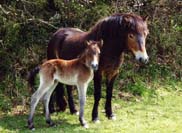| |||||||||||||||
| |||||||||||||||
|
|||||||||||||||||||||||||||
| The Coat Exmoor ponies come in varying shades of brown with mealy coloured muzzles and mealy colouring around their eyes, under their bellies and inside their hind legs. The winter coat should comprise of an inner layer of soft, woolly hair to insulate the pony and keep it warm, with an over layer of longer guard hairs to shed water and keep the pony dry. A really efficient, double-layered waterproof winter coat is essential to an Exmoor pony living on hill ground in winter. The whorls in the coat should shed the water so that it does not run under the belly and chill the pony. The winter coat tends to be very greasy which serves to waterproof it. Short hairs at the top of the tail tend to give a bell or fan-shaped appearance. Wet rather than cold is most likely to cause the loss of body condition. Hill ponies need no grooming. Their greasy coats are best left undisturbed to maximise their weather protection qualities. In summer the coat should be short and hard, but still waterproof. Living free, hill ponies shed the guard hairs first in the spring; the undercoat lingers longer. Often, they start to grow their new winter coat in August, so really are only seen in summer coat for a couple of months. An efficient winter coat is probably the most important factor influencing how well a pony will survive living free in winter - the chill factor of wet, cold, windy weather can most affect their body condition. |
 |
||||||||||||||||||||||||||
| Conformation | |||||||||||||||||||||||||||
| 'A Leg at Each Corner' Exmoor ponies standing should have a 'leg at each corner'. The ponies legs should be straight when viewed from in front or behind with no tendency to pigeon toes or splay feet in front or to sickle or cow hocks behind. When the pony moves, its legs should all move forward straight from the shoulder and hip. The only exception should be that the hind legs can step under the centre of gravity to help the pony balance at times. There should be no dishing in front or waddling behind with wide hocks. There should be no exaggerated knee action or daisycutting action. The pony has to be able to move through thick heather and over stones and tussocks in its natural environment. There should therefore be economical movement which propels the pony forwards with enough cadence to prevent it tipping. The hocks should flex under the body to provide the forward propulsion. Ideally, in walk and trot, the Exmoor should 'track up'. This means that when the pony places its hind hoof on the ground, the imprint it leaves should coincide or appear in front of the imprint left by the front hoof. Ponies that do not track up will not give a balanced ride. Also, ponies that walk well will usually gallop. At the canter, the movement should look easy. All paces should be fairly ground covering without exaggeration. The hooves should give the impression of being well placed on the ground, not striking the ground or floating either. This is important as it ensures sure-footedness. If the pony moves correctly, it should wear its feet evenly. An Exmoor pony needs activity with economy, to enable it to travel safely without expending too much effort - moving over fair distances in a day in order to forage over a large acreage. All these elements are designed to minimise the likelihood of the pony becoming lame - in short, the ponies action has been evolved to help it cope with survival in its natural way of life. |
� |
||||||||||||||||||||||||||
|
|||||||||||||||||||||||||||
�
ADVERTISE on Equinetourism.co.uk - Click here
SEARCH FOR CONTENT ON EQUINETOURISM.CO.UK |

Also see www.EquineTourismCommunity.com and www.EquineTourism.com
email: [email protected] - Telephone 00 44 (0)1643 862785
www.EquineTourism.co.uk is owned by Happy Horses Ltd, Holt Ball, Luccombe, Minehead, Exmoor, Somerset TA24 8SZ
Full worldwide copyright and all rights retained �2004-2015 ongoing Happy Horses Ltd. Please read our Disclaimer
horse riding, horse riding holidays, horse holidays, riding horses, riding lessons, riding schools, equestrian pursuits, natural horsemanship, horses and ponies